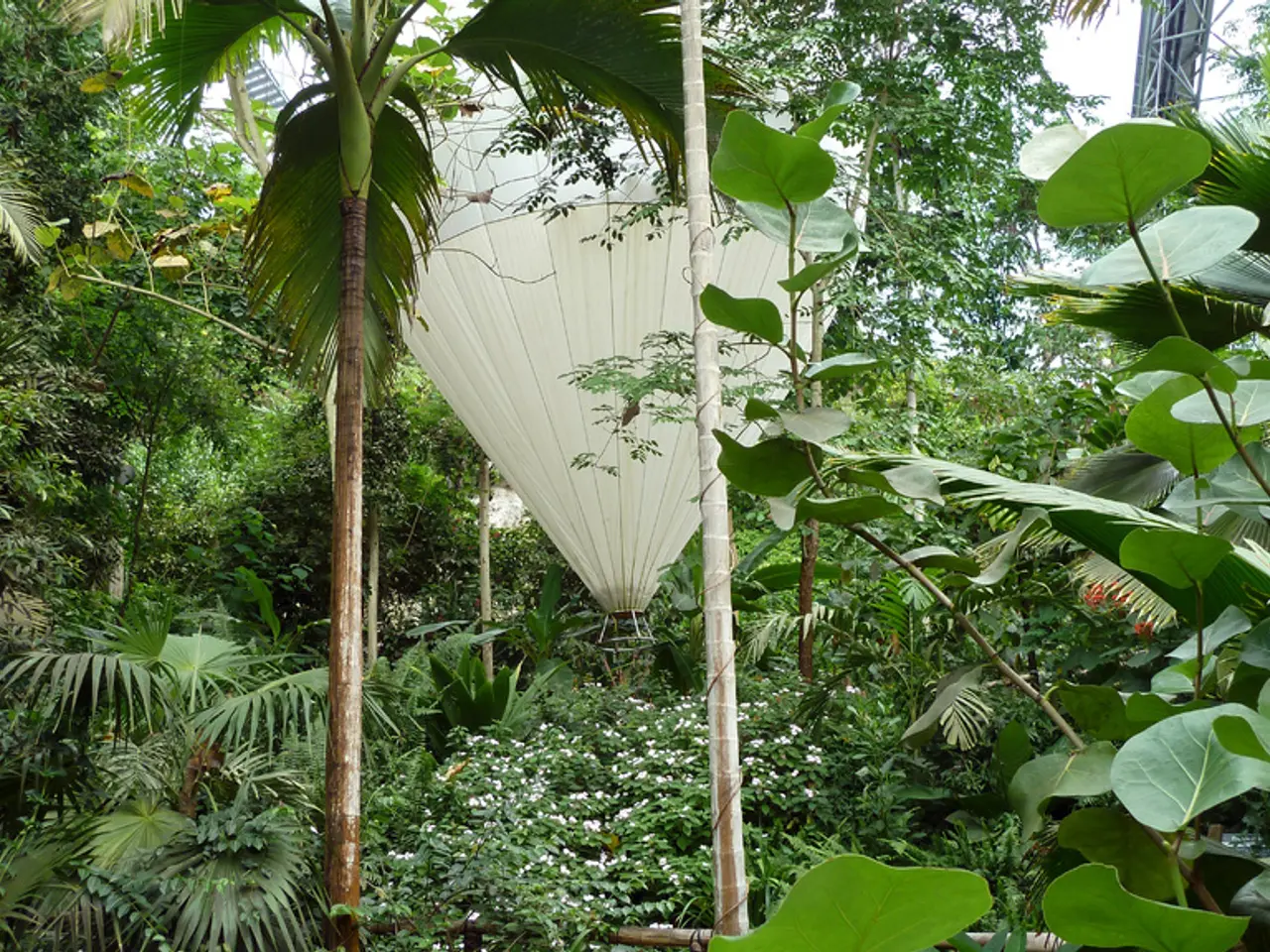Beware! Appealing Flora May Harm Your Garden's Tranquility
Once you step foot into your local garden center, you'll find a lush array of plants, vines, and flowers that promise a touch of paradise in your backyard. But let me tell you, some of these "darlings" are ticking time bombs ready to wreak havoc on your garden.
As a green thumb just starting out, you might think you're getting an easy-going vine or an aromatic herb. But the truth is, you're opening the gates to an invasive, unwelcome guest that'll spread like wildfire and take over your garden.
So, let's get the inside scoop from garden gurus like Catherine Stewart, a multiple award-winning garden journalist, Lauren Landers, a wordsmith with Gardening.org, and Julie, a Master Gardener and Naturalist with Gingham Gardens. Here's a compendium of the 13 challenging plants you should think twice about before planting them in your garden.
What Makes a Plant a Danger to Your Garden?
Many of these plant offenders are peddled at local nurseries with tags boasting quick coverage, effortless growth, low maintenance, or vibrant blooms. It's nothing but clever marketing designed to get you packing as many plants as possible without a care for your garden's future.
They might be invasive, aggressive, or toxic, but they share common characteristics you need to be aware of:
- Rapidly spreading underground roots (rhizomes or stolons)
- Thick, ground-hugging foliage
- High seed production and self-seeding behavior
- Allelopathy (using chemical warfare to inhibit growth)
- No natural predators or "checks" in your region
Keeping an eye on these plant traits can help protect your garden from unwanted intruders and keep your dream garden alive.
Type 1: Vining Plants and Creepers
Vines offer fast coverage and stunning blooms, helping you create a romantic, cottage-style garden. But be cautious, as some vines can be a headache you don't want. Once planted, they'll crawl, climb, strangle, destroy, and never leave.
English Ivy
English Ivy is a classic vine that's great for climbing fences and walls. But it's also a silent destroyer, forming a dense mat that can deny sunlight to your understory plants as it climbs and crushes them. English Ivy doesn't respond well to herbicides, so your best bet is repeated scraping, cutting, and chemical treatments over months and years to control it.
Wisteria
With its beautiful, cascading lavender flowers, wisteria is like something out of a fairytale. But as it grows, it conquers – strangling trees, crushing fences, and even pulling down pergolas. Underground shoots can emerge several feet away from the mother plant, establishing new colonies that can continue to take over unless you keep their growth in check. The hardest part is that cutting back wisteria doesn't do much other than make it grow more vigorously. Eradicating it involves scraping stems and applying undiluted herbicides over several seasons.
Morning Glories
Colorful and charming, morning glories can engulf your entire flower bed if left unchecked. Morning glories self-seed aggressively, with gorgeous flowers in year one resulting in thousands of volunteers the next spring. To keep them from overtaking your garden, cut back the vine regularly, and remove any volunteers to ensure your garden stays lush and vibrant.
Type 2: Groundcovers That (Can) Choke Everything
Groundcovers are known for their easy care, ability to suppress weeds, and maintenance-free nature. However, some popular choices can escape their designated space, wreaking havoc on your garden and other unwanted areas.
Vinca Major/Minor (Periwinkle)
Vinca was once the darling of shady landscapes, but its unfortunate ability to take over areas with unchecked sprawl has tarnished its reputation. The problem with Vinca is that it creates dense mats that smother anything that tries to exist underneath. It's also incredibly difficult to get rid of because its waxy leaves are highly resistant to common herbicides, and it spreads easily from its ability to root wherever its stolons touch soil.
Creeping Jenny
The soft, chartreuse leaves and trailing habits of creeping jenny make it a fan favorite for containers. But once it's planted in the ground, you can quickly have a problem on your hands. Creeping Jenny spreads laterally using shallow roots that are best controlled by physically removing the plant and applying herbicide as a spot treatment.
Mint
Mint is a fan favorite. It smells great, is delicious in teas or a mojito, and is known to repel a variety of pests. However, once planted in the ground, mint sends out runners above ground and rhizomes below ground, quickly spreading through lawns, raised beds, gravel, and even cracks in the pavement. Mint is so prolific that it can even regenerate from the smallest root fragment. As much as you might love mint, it's best to keep it in containers to avoid the headache of trying to dig it out after it's been planted in the ground.
Type 3: Shrubs and Bushes That Outcompete Natives
Shrubs are used to add structure, color, and privacy to an area. However, some popular choices have a dark side – they spread aggressively, offer little to no ecological value, and can outcompete native plants that pollinators and wildlife rely on.
Burning Bush
Burning bush is a fall favorite that earns its name through a brilliant crimson display of leaves. Unfortunately, it's a prolific spreader through birds that consume its berries and deposit them far and wide. Once burning bush is established in woodlands or field edges, it will form dense thickets that crowd out native undergrowth and alter soil chemistry. Because of this behavior, several states have banned the sale of burning bush, including Massachusetts, Maine, and New Hampshire.
Butterfly Bush
Often touted for its ability to support pollinators, butterfly bush is actually doing a bit of false advertising. It offers no food or habitat for caterpillars, which makes it a dead-end in the pollinator lifecycle. What's more challenging from a home maintenance standpoint is that the butterfly bush is a prolific self-seeder that can quickly dominate entire beds, choking out slower-growing native shrubs and perennials.
Privet
Privet is a popular hedge that offers privacy and is often used to denote property lines. Unfortunately, it also screens out all nearby plants because privet is fast-growing, tolerant of poor soil, and nearly indestructible. To eradicate a mature privet hedge, chainsaws and heavy digging equipment are often required.
Type 4: Tricky Trees
We love trees for their structure, beauty, and oxygen-producing benefits. However, some trees can be a little less popular because of their ability to poison the soil, steal the sunlight, and turn your garden into a dead zone. Let's look at specific trees you might want to avoid.
Leyland Cypress
If you've ever admired a wall of perfectly trimmed conifers, think again. Leyland cypress grows fast, up to four feet a year, forming an impenetrable green curtain. Ultimately, once mature, it blocks all light, sucks nutrients from the soil, and casts deep shade that prevents anything from growing beneath or beside it.
Black Walnut
Majestic and long-lived, black walnuts are native to North America. However, they don't play nicely with others. Black walnuts exude juglone, a natural chemical that inhibits growth or outright kills nearby plants. The juglone is also found in fallen leaves, nut husks, and decaying black walnut wood, which can make cleanup a high-stakes operation. Plant these trees with care, and whatever you do, don't put any parts of the black walnut tree in your compost bin.
Norway Maple
While it may look like the classic, beloved maple tree, the Norway maple is a foreign invader that is anything but friendly. Norway maple spreads aggressively by seed, tolerating a wide range of soil and light conditions. Once established, the Norway maple creates a dense canopy that blocks out rain, growth, and sunlight, and starves out native undergrowth. Many nurseries still continue to sell Norway maples, despite their invasive reputation, so beware!
Type 5: The Bamboo Nightmare
Of all the invasive horrors lurking in garden centers, few strike fear into the hearts of landscapers like running bamboo. On the surface, bamboo seems like the perfect privacy solution due to its tall, fast-growing, and graceful allure. However, bamboo spreads prolifically through underground rhizomes that can travel anywhere from 30 to 40 feet from the original plant. Getting rid of bamboo often involves heavy machinery, concrete root barriers, repeated herbicide use, and years of digging.
It's easy to get swept up in the enchantment of garden center tags with enticing words like fast-growing, low-maintenance, or perfect for privacy. However, it's important to do your research before adding new plants to your garden. Avoid invasive species and plant native alternatives to support local wildlife, conserve water, reduce maintenance, and help prevent invasive plant establishment.
— Kelsey McDonough (@kelseymcdonoh19) is a freelance writer and scientist, covering topics from gardening and homesteading to hydrology and climate change. She is a certified Master Gardener in Colorado and holds a Ph.D. in biological and agricultural engineering.
Enrichment Data:- Many invasive plants like Mexican feather grass, fountain grass, French broom, pampas grass, giant reed (arundo), eucalyptus, ice plant, vinca, and tree tobacco can destroy native ecosystems, requires significant effort and resources to control, and is often impossible to fully eradicate once established.- Aggressive plants like morning glory and creeping jenny can quickly grow and smother other plants, making them difficult to control.- Some invasive plants are also toxic, such as tree tobacco, making them hazardous for humans and animals.- Native plants are recommended as they support local wildlife, conserve water, reduce maintenance, and help prevent invasive plant establishment.
- Keeping an eye on plant traits like rapid spreading roots, thick foliage, high seed production, allelopathy, and no natural predators in your region can help protect your garden from invasive species.
- English Ivy, while attractive for climbing fences and walls, forms a dense mat that can deny sunlight to understory plants and crush them, making it difficult to control.
- Wisteria, with its beautiful lavender flowers, can strangle trees, crush fences, and pull down pergolas. Its growth isn't easily controlled by cutting back; eradicating it involves scraping stems and applying undiluted herbicides over several seasons.
- Morning glories, though colorful and charming, can engulf entire flower beds if left unchecked due to their aggressive seed production and self-seeding behavior.
- Vinca Major/Minor (Periwinkle) forms dense mats that smother anything underneath it and is difficult to get rid of because its waxy leaves are highly resistant to common herbicides.
- Mint, while popular for its scent and usefulness in teas, can quickly spread through lawns, raised beds, gravel, and even cracks in pavement due to above-ground runners and underground rhizomes.
- Butterfly Bush, while touted for supporting pollinators, offers no food or habitat for caterpillars and can quickly dominate entire beds, choking out slower-growing native shrubs and perennials.







